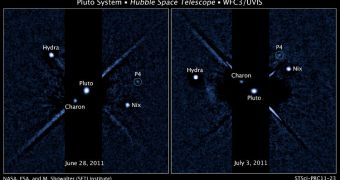As the fastest spacecraft ever built is heading towards Pluto, mission controllers met with planetary scientists to discuss how to safeguard the New Horizons probe from instant destruction as it reaches the dwarf planet. This is scheduled to occur in July 2015.
While the object and its four moons are well understood, other pieces of space debris that could exist at that location are not. Pluto does not fulfill the third criterion for being classified as a planet, which is clearing its orbit of other materials.
In other words, it could be that the Plutonian system is surrounded by small grains of sand, pebbles and other similar debris, all traveling at tens of thousands of kilometers per second. A single impact from a pebble just 1 millimeter across could spell instant death for New Horizons.
Also, it was recently discovered that the four moons orbiting Pluto – called Charon, Nix, Hydra and P4 – are constantly being hit by debris from around the Kuiper Belt. The latter is a section of the solar system located beyond the orbit of Neptune, which includes comets, asteroids and other space rocks.
What is interesting about the moons is that their gravitational pull is so weak that they don't hold on to the debris that hit them. This means that a rock which slams into Nix, for example, would bounce right off the moon's surface, and join what may very well be a halo of space junk around Pluto.
When New Horizons arrives at the dwarf planet, it has to ensure that it will not hit any such object. However, doing so will be an extremely complex process, investigators say, primarily due to the fact that not even the space probe's extremely-sensitive instruments will be able to detect small pebbles.
Yet, each of these little rocks has the ability to destroy the spacecraft entirely in case a collision occurs. “The most likely problem we would encounter is to be hit by something that is large enough to instantly destroy the spacecraft,” explains Alan Stern, as quoted by Space.
The expert, who holds an appointment with the San Antonio, Texas-based Southwest Research Institute (SwRI), is the principal investigators for the New Horizons mission. He explains that the probe will turn on its cameras months before the scheduled arrival at Pluto.
Even then, it will only be able to detect objects that are of considerable size. But even a milligram of fast-moving space rock can pass clean through the spacecraft, potentially disabling vital electronic systems, damaging its heat shield and compromising it in full.
One possible course of action would be to take on a safer, more distant path, which would take New Horizons through the orbit of Charon. The probe would travel on the other side of Pluto in reference to the moon.
The reason for this is that Charon constantly removes debris from its path as it moves in its orbit, creating a relatively safe way for the NASA mission to try out.

 14 DAY TRIAL //
14 DAY TRIAL //